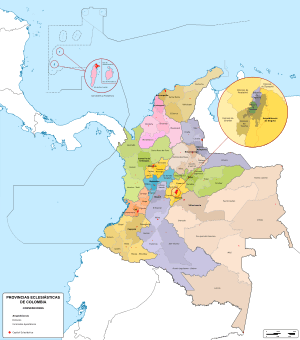Catholic Church in Colombia

The Catholic Church in Colombia is currently organized into 13 ecclesiastical provinces, subdivided into 13 archdioceses and 52 dioceses total, given at List of Roman Catholic dioceses in Colombia. There are over 120 different religious orders, institutes, and lay organizations running hundreds of primary and secondary schools, hospitals, clinics, orphanages, colleges, and 8 universities, the best known being Pontificia Universidad Javeriana (in Cali) and Pontificia Universidad Javeriana (in Bogotá), both Jesuit universities.[1] There are 74 dioceses and other territorial jurisdictions.
The National Administrative Department of Statistics (DANE) does not collect religious statistics, and accurate reports are difficult to obtain. However, based on various studies and a survey, about 90% of the population adheres to Christianity, the majority of which (70.9%) are Roman Catholic, while a significant minority (16.7%) adhere to Protestantism (primarily Evangelicalism).[2][3][4]
History
Catholicism was introduced in 1508. Two dioceses were organized in 1534. There was appreciable Church growth by the mid-17th century, in spite of the variety of Indian languages, government interference, and competition among religious orders. Some persecution followed the declaration of independence from Spain, in 1819.
The church and the state
In today 's Colombia , and throughout Latin America , the Church was subject to state and served their purpose, throughout the colonial period and part of the nineteenth century. Therefore, he was responsible for founding and directing schools for the education of native elites ( San Bartolome , El Rosario and the University of St. Thomas ), create and sustain hospitals, help in the colonial bureaucracy and generally , as an instrument of Control and social cohesion.
In the late eighteenth century, with the Bourbon reforms begins to crack this scheme, especially in the educational aspect. For the first time questioned the usefulness of the system scholastic used until then, and a progressive implementation of educational programs illustrated dye is sought.
At the time of Independence , the clergy was split between those who supported the king ( realistic ) and those who preferred the absolute independence ( patriots ). The high clergy (bishops and dignitaries) preferred to support the former, while parish priests and many of the religious, to the latter. Research suggests that the role played by the clergy in Independence was decisive, because it contributed to the mobilization and recruitment of people (due to their remarkable influence on the people); they even serve as chaplains and military leaders.
There is a strong and strong influence of Catholicism on public opinion and even in government affairs. The Catholic Church has a presence in various fields and institutions among which include:
- Military and Police Forces. Catholic chaplaincies have; the Bishopric of Colombia Castrense serves exclusively as staff diocese and retired to active staff and family members of the Colombian Armed Forces (Army, Air Force and Navy) and the National Police.
- The Apostolic Nunciature , is the embassy of the Holy See in the country.
- The high degree of faithful of this church in the total population, about 90% define themselves as Catholics.
- The delivery of official or public for the construction of Catholic churches land.
- The Concordat with the Holy See exists and is in force since 1886; despite having character of "international treaty perfected", the Constitutional Court declared some of its provisions in 1993. 1 The Colombian Bishops ' Conference spoke against two weeks later. 2
- The proportion of Catholics in the country causes it to become common to refer to the population and the Catholic hierarchy simply as "the Church".
Since 1991
With the Constitution of Colombia of 1991 the Colombian State stops being denominational Catholic, equality and religious freedom recognized. Although the state does not keep official statistics on religious affiliation, a survey of 2001 revealed by the newspaper El Tiempo , indicates that 80% of the population is Catholic.
On June 22, 2012, many media in Colombia and the world, published the report titled "The Pope is concerned about penetration Pentecostals in Colombia" where Benedict acknowledged the cultural impact of Pentecostals in the idiosyncrasies of this country . Benedict XVI affirmed that "While years ago it was possible to recognize a unitary cultural fabric [based on Roman Catholicism] ... The growing religious pluralism is a factor that requires serious consideration. The increasingly active presence of Pentecostal and Evangelical communities not only in Colombia, but also in many parts of Latin America it can not be ignored or undervalued " 3
On October 31, 2012 Bishop Juan Vicente Córdoba, Secretary General of the Colombian Episcopal Conference , announced that the Catholic Church would seek parishioners in shopping centers , placing parishes in these commercial establishments. 4
The beatification of Mariano de Jesus Euse Hoyos (the "father Marianito") and 7 religious of San Juan de Dios in May and, above all, the canonization of Mother Laura Montoya , founder of the Missionaries of Mary Immaculate and St. Catherine of Siena (lauritas), had great news coverage. His contribution goes beyond the religious aspect, it comes to have ethnographic implications in June and policies.
See also
Notes
- ↑ Annuario Pontificio, 2009.
- ↑ Beltrán Cely, William Mauricio. "Del monopolio católico a la explosión pentecostal'" (PDF) (in Spanish). Universidad Nacional de Colombia, Facultad de Ciencias Humanas, Centro de Estudios Sociales (CES), Maestría en Sociología. ISBN 978-958-761-465-7.
- ↑ Beltrán Cely, William Mauricio. "Descripción cuantitativa de la pluralización religiosa en Colombia" (PDF). Universitas humanística 73 (2012): 201–238. – bdigital.unal.edu.co.
- ↑ "Religion in Latin America, Widespread Change in a Historically Catholic Region". pewforum.org. Pew Research Center. November 13, 2014.
